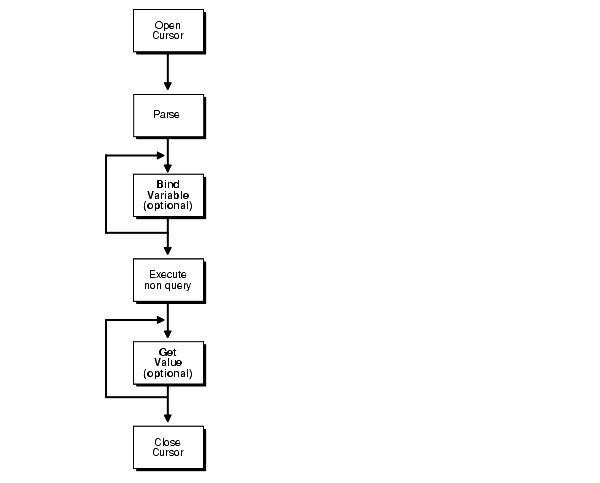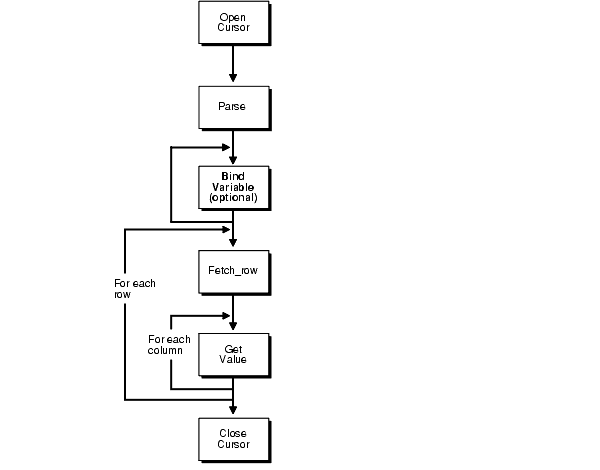Passthrough SQL
The passthrough SQL feature enables you to send a statement directly to a non-Oracle system without first being interpreted by Oracle Database.
This feature can be useful if the non-Oracle system allows for operations in statements for which there is no equivalent in Oracle.
- DBMS_HS_PASSTHROUGH Package
You can execute passthrough SQL statements directly on the non-Oracle system using the PL/SQL packageDBMS_HS_PASSTHROUGH. - Implications of Using Passthrough SQL
When you execute a passthrough SQL statement that implicitly commits or rolls back a transaction in a non-Oracle system, the transaction is affected. - Executing Passthrough SQL Statements
This section describes the functions and procedures provided by theDBMS_HS_PASSTHROUGHpackage that enable you to execute passthrough SQL statements.
Parent topic: Features of Oracle Database Gateways
DBMS_HS_PASSTHROUGH Package
You can execute passthrough SQL statements directly on the non-Oracle system using the PL/SQL package DBMS_HS_PASSTHROUGH.
Any statement executed with this package is executed in the same transaction as standard SQL statements.
The DBMS_HS_PASSTHROUGH package is a virtual package. It conceptually resides on the non-Oracle system. In reality, however, calls to this package are intercepted by Heterogeneous Services and are mapped to one or more Heterogeneous Services calls. The driver then maps these Heterogeneous Services calls to the API of the non-Oracle system. The client application invokes the procedures in the package through a database link in the same way as it would invoke a non-Oracle system stored procedure. The special processing done by Heterogeneous Services is transparent to the user.
See Also:
Oracle Database PL/SQL Packages and Types Reference for more information about this package
Parent topic: Passthrough SQL
Implications of Using Passthrough SQL
When you execute a passthrough SQL statement that implicitly commits or rolls back a transaction in a non-Oracle system, the transaction is affected.
For example, some systems implicitly commit the transaction containing a data definition language (DDL) statement. Because Oracle Database is bypassed, Oracle Database is unaware that a transaction was committed in the non-Oracle system. Consequently, the data at the non-Oracle system can be committed, while the transaction in Oracle Database is not.
If the transaction in Oracle Database is rolled back, data inconsistencies between Oracle Database and the non-Oracle system can occur. This situation results in global data inconsistency.
Note that if the application executes a typical COMMIT statement, Oracle Database can coordinate the distributed transaction with the non-Oracle system. The statement executed with the passthrough facility is part of the distributed transaction.
Parent topic: Passthrough SQL
Executing Passthrough SQL Statements
This section describes the functions and procedures provided by the DBMS_HS_PASSTHROUGH package that enable you to execute passthrough SQL statements.
Table 3-1 DBMS_HS_PASSTHROUGH Functions and Procedures
| Procedure/Function | Description |
|---|---|
|
|
Opens a cursor. |
|
|
Closes a cursor. |
|
|
Parses the statement. |
|
|
Binds |
|
|
Binds |
|
|
Binds |
|
|
Executes a nonquery statement. |
|
|
Executes a nonquery statement without bind variables. |
|
|
Fetches rows from query. |
|
|
Retrieves column value from |
- Executing Nonqueries
Nonqueries include the statementsINSERT,UPDATE, andDELETEand other DDL types of statements. - Executing Queries
Use passthrough SQL to execute queries.
Parent topic: Passthrough SQL
Executing Nonqueries
Nonqueries include the statements INSERT, UPDATE, and DELETE and other DDL types of statements.
To execute nonquery statements, use the EXECUTE_IMMEDIATE function. For example, to execute a DDL statement on a non-Oracle system that you can access using the database link salesdb, enter the following:
DECLARE
num_rows INTEGER;
BEGIN
num_rows := DBMS_HS_PASSTHROUGH.EXECUTE_IMMEDIATE@salesdb
('CREATE TABLE dept1 (n SMALLINT, loc CHARACTER(10))');
END;
The variable num_rows is assigned the number of rows affected by the statements that were executed. For DDL statements, zero is returned. Note that you cannot execute a query with EXECUTE_IMMEDIATE function and you cannot use bind variables.
- Overview of Bind Variables
Bind variables let you use the same SQL statement multiple times with different values, reducing the number of times a SQL statement needs to be parsed. - IN Bind Variables
The syntax of the non-Oracle system determines how a statement specifies aINbind variable. - OUT Bind Variables
The non-Oracle system can supportOUTbind variables. - IN OUT Bind Variables
A bind variable can be both anINand anOUTvariable.
Parent topic: Executing Passthrough SQL Statements
Overview of Bind Variables
Bind variables let you use the same SQL statement multiple times with different values, reducing the number of times a SQL statement needs to be parsed.
For example, when you insert four rows in a table, you can parse the SQL statement once, and bind and execute the SQL statement for each row. One SQL statement can have zero or more bind variables.
To execute passthrough SQL statements with bind variables, you must:
-
Open a cursor.
-
Parse the SQL statement on the non-Oracle system.
-
Bind the variables.
-
Execute the SQL statement on the non-Oracle system.
-
Close the cursor.
Figure 3-1 shows the flow diagram for executing nonqueries with bind variables.
Figure 3-1 Flow Diagram for Nonquery Passthrough SQL
Parent topic: Executing Nonqueries
IN Bind Variables
The syntax of the non-Oracle system determines how a statement specifies a IN bind variable.
For example, on an Oracle system you define bind variables with a preceding colon. For example:
... UPDATE emp SET sal=sal*1.1 WHERE ename=:ename; ...
In this statement, ename is the bind variable. On non-Oracle systems, you may need to specify bind variables with a question mark. For example:
... UPDATE emp SET sal=sal*1.1 WHERE ename= ?; ...
In the bind variable step, you must positionally associate host program variables (in this case, PL/SQL) with each of these bind variables. For example, to execute the preceding statement, use the following PL/SQL program:
DECLARE
c INTEGER;
nr INTEGER;
BEGIN
c := DBMS_HS_PASSTHROUGH.OPEN_CURSOR@salesdb;
DBMS_HS_PASSTHROUGH.PARSE@salesdb(c,
'UPDATE emp SET SAL=SAL*1.1 WHERE ename=?');
DBMS_HS_PASSTHROUGH.BIND_VARIABLE@salesdb(c,1,'JONES');
nr:=DBMS_HS_PASSTHROUGH.EXECUTE_NON_QUERY@salesdb(c);
DBMS_OUTPUT.PUT_LINE(nr||' rows updated');
DBMS_HS_PASSTHROUGH.CLOSE_CURSOR@salesdb(c);
END;Parent topic: Executing Nonqueries
OUT Bind Variables
The non-Oracle system can support OUT bind variables.
With OUT bind variables, the value of the bind variable is not known until after the execution of the SQL statement.
Although OUT bind variables are populated after executing the SQL statement, the non-Oracle system must know that the particular bind variable is an OUT bind variable before the SQL statement is executed. You must use the BIND_OUT_VARIABLE procedure to specify that the bind variable is an OUT bind variable.
After executing the SQL statement, you can retrieve the value of the OUT bind variable using the GET_VALUE procedure.
Parent topic: Executing Nonqueries
IN OUT Bind Variables
A bind variable can be both an IN and an OUT variable.
This means that the value of the bind variable must be known before executing the SQL statement, but you can change the value after the SQL statement is executed.
For IN OUT bind variables, you must use the BIND_INOUT_VARIABLE procedure to provide a value before executing the SQL statement. After executing the SQL statement, you must use the GET_VALUE procedure to retrieve the new value of the bind variable.
Parent topic: Executing Nonqueries
Executing Queries
Use passthrough SQL to execute queries.
The difference between queries and nonqueries is that queries retrieve a result set from a SELECT statement. The result set is retrieved by using a cursor.
Figure 3-2 illustrates the steps in a passthrough SQL query. After the system parses the SELECT statement, each row of the result set can be retrieved with the FETCH_ROW procedure. After the row is retrieved, use the GET_VALUE procedure to retrieve the selected list of items into program variables. After all rows are retrieved, you can close the cursor.
You do not have to retrieve all the rows. You can close the cursor at any time after opening the cursor.
Note:
Although you are retrieving one row at a time, Heterogeneous Services optimizes the round-trips between Oracle Database and the non-Oracle system by buffering multiple rows and fetching from the non-Oracle data system in one round-trip.
The following example executes a query:
DECLARE
val VARCHAR2(100);
c INTEGER;
nr INTEGER;
BEGIN
c := DBMS_HS_PASSTHROUGH.OPEN_CURSOR@salesdb;
DBMS_HS_PASSTHROUGH.PARSE@salesdb(c,
'select ENAME
from EMP
where DEPTNO=10');
LOOP
nr := DBMS_HS_PASSTHROUGH.FETCH_ROW@salesdb(c);
EXIT WHEN nr = 0;
DBMS_HS_PASSTHROUGH.GET_VALUE@salesdb(c, 1, val);
DBMS_OUTPUT.PUT_LINE(val);
END LOOP;
DBMS_HS_PASSTHROUGH.CLOSE_CURSOR@salesdb(c);
END;
After the SELECT statement has been parsed, the rows are fetched and printed in a loop until the FETCH_ROW function returns the value 0.
Parent topic: Executing Passthrough SQL Statements

